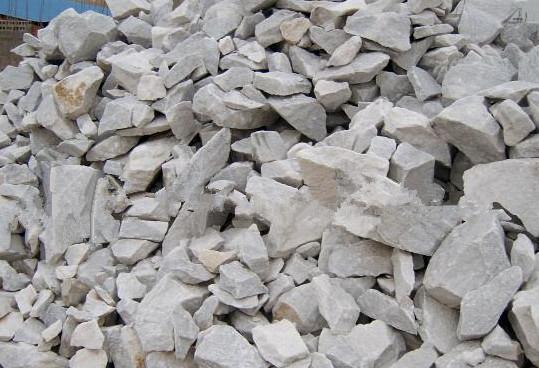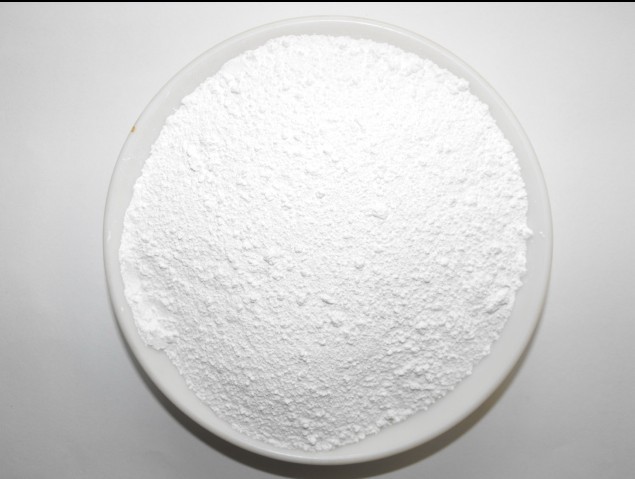Dolomite has a wide range of uses. It is a glass, chemical, enamel, welding material, curing, refractory material, dolomite powder (double fly powder) architectural coatings, and ultra-fine double fly powder is a filler for plastic steel.

The chemical composition is CaMg[CO3]2, and the crystal is a carbonate mineral of the trigonal crystal system. The crystal structure of dolomite is similar to that of calcite. The crystal form is rhombohedron, and the crystal face is often bent into a saddle shape. The poly-sheet twin crystals are common, mostly in the form of massive and granular aggregates. Pure dolomite is white, because it contains other elements and impurities, sometimes it is gray-green, gray-yellow, pink and other colors, and the glass is shiny. The three groups of rhombohedrons are completely cleavage and brittle. Mohs hardness is 3.5-4, specific gravity is 2.8-2.9. Mineral powder reacts slowly in cold dilute hydrochloric acid.
The dolomite ore is ground by a
mill to obtain ultra-fine dolomite powder from 325 mesh to 2500 mesh. After modification, it can be used in many industries.

The Uses of dolomite powder
1. Metallurgical industry
1.1 Magnesium smelting industry
1.2 Refractories
Dolomite is one of the important raw materials for alkaline refractories, and its importance is second only to magnesite. Mainly used for steel-making converter lining, open hearth furnace, electric furnace wall. Secondly, it is used in thermal equipment such as refining equipment outside the furnace and cement kiln.
It is also reported that the hydration resistance of fired direct-bonded dolomite bricks is 4 times higher than that of asphalt-bonded bricks, and the hydration resistance of fired bricks can be further improved after being impregnated with asphalt.
1.3 Hole plugging materials for ironmaking blast furnace
According to reports, WISCO once used dolomite with a raw ore grain size of 0-30 mm directly as a blast furnace hot metal pore plugging material. If 0-30 mm dolomite burnt white is used as a material for plugging molten iron pores in a steelmaking blast furnace, the effect will be better than that of direct use as a material for blocking molten iron pores. The selling price is about 1,000 yuan/t, which has a good prospect.
2. Chemical industry
2.1 Production of magnesium carbonate
The production of magnesium carbonate requires the chemical composition (%) of dolomite as follows: MgO>18, CaO>29, SiO2<4, there is no definite requirement for the content of K2O, Na2O and acid insoluble matter. At present, there are mainly three types of magnesium carbonate produced: light magnesium carbonate, light spherical magnesium carbonate and light transparent magnesium carbonate.
(1) Production and application of light magnesium carbonate.
(2) Production and application of light spherical magnesium carbonate.
(3) Production and application of light transparent magnesium carbonate.
2.2 Production of Magnesium Oxide
As a filler, magnesium oxide is widely used in industries such as rubber, enamel, wire and cable. In addition, magnesium oxide is also an indispensable refractory material. At present, the new domestic process for extracting magnesium oxide from dolomite is the dolomite recycling method.
In addition, the production process and method for preparing special silicon steel grade magnesium oxide using dolomite as the main raw material has also been developed.
2.3 Production of magnesium sulfate
Magnesium sulfate crystals
(MgSO4•7H2O), also known as diarrhea salt, is used in medicine, agriculture, cement, printing and dyeing, food, etc. At present, the magnesium sulfate industry is developing relatively rapidly in the world. It mainly produces MgSO4•7H2O through the extraction of bitter seeds or sun exposure in sea beaches. There are also reports of using dolomite as a raw material to prepare MgSO4•7H2O crystals by the sulfuric acid method.
Using dolomite to prepare magnesium sulfate can not only obtain magnesium sulfate (MgSO4•7H2O) crystals, but also can obtain by-product CaSO4•H2O.
2.4 Production of magnesium hydroxide
The production of magnesium hydroxide, in addition to the intermediate process of producing magnesium oxide above, can also be obtained by dolomite ammoniating method or acid method decomposing dolomite.
2.5 Production of dolomite powder
Dolomite is sorted, crushed, and ground to 325-1250 meshes to become dolomite powder. The purpose of modification is to change the surface alkalinity of dolomite powder, overcome the bonding performance between filler and rubber, reduce shrinkage and internal stress, prevent crack propagation, and improve the processing performance of product strength.
2.6 Production of nano calcium carbonate coated dolomite powder
3. Building materials industry
3.1 Development of Magnesium Cementitious Materials
The main raw material of magnesia cementing material is MgO, which is produced with magnesite as raw material. Now people are considering using dolomite instead of magnesite to produce MgO. Magnesium-containing cement has been widely used in floor tiles, fast-setting pavement paving, and repair of pavement cracks. In addition, after calcining dolomite to produce caustic dolomite, it can also be processed into magnesium hydroxide cement and magnesium oxide sulfate cement. These two non-hydraulic cementitious materials have the advantages of simple production process, fast setting and hardening, high strength, strong bonding force, good elasticity, wear resistance, convenient molding, low energy consumption, etc., and have high development and use value. It can be used to produce plastering mortar, concrete, wood-like magnesite products (sawn wood, particle board, sound insulation board, thermal insulation board) and artificial marble, etc., especially for cementing organic materials and filling damaged, cracked and peeled parts of cement products . Magnesite floor tiles have the elasticity, toughness and thermal insulation properties of wooden floors, and can be fireproof and mothproof, have good water resistance, no cracking, and low price. It is made of magnesium-containing cement (magnesium chloride or magnesium sulfate solution mixed with caustic dolomite powder) as a cementing material, and some fillers are added. Adding 10% to 20% of additives (red shale, fly ash, talc or dolomite powder) in magnesium-containing cement can overcome the defects of magnesite floor tiles such as easy warping and deformation, surface moisture absorption and halogen return. It is widely used on the ground, wall and column surface of industrial plants, public buildings and civil buildings.
In recent years, with the continuous development of the construction industry, the development and application of siliceous dolomite has been promoted. Dolomite has not only become the main mineral raw material for artificial marble and terrazzo (light) stone, but also some densely structured and fine-textured dolomites have also been rapidly developed as decorative materials and craft materials. It is reported that the magnesia composite material fired with high-quality dolomite as the main material is further processed into new decorative materials such as floor tiles, wall tiles and boards. It has many characteristics such as light weight, high strength, anti-aging, and beautiful appearance. , Deeply favored by people. Decorative railings and ornaments made of dolomite as the main material are also very popular.
3.2 Application in glass production
3.2.1 Production of glass
Dolomite and limestone are the third largest components of glass raw materials except silica sand and soda ash. In the production of bottle glass, soda ash is the most expensive component. The addition of limestone can partially replace soda ash, but it will have adverse effects. The introduction of magnesium oxide in dolomite can further reduce costs. Dolomite can also provide calcium oxide in the glass industry, adding soda-ash-silica system to act as a flux. In addition, dolomite can also reduce glass aging, prevent chemical corrosion caused by the atmosphere or moisture, improve the plasticity of colored glass, and increase the strength of glass.
3.2.2 Production of glass-ceramics
Gold tailings, dolomite, etc. are used as raw materials, and Cr2O3 is a nucleating agent to make glass-ceramics and cast stone sheet products. Its performance indicators are better than natural marble and granite. It is suitable for building materials, chemical corrosion-resistant materials or Wear-resistant materials used in metallurgy and mining industries have opened up an effective way to solve the problem of environmental pollution.
3.3 Application in ceramic production
4. Other industries
4.1 Application in agriculture
Used to neutralize the acidity in the soil. Since long-term use of urea and other fertilizers is easy to cause the soil to be acidic, dolomite can be directly added to the urea to keep the soil at an appropriate pH value, which can generally increase crop yields by 15% to 40%, and can also improve the efficacy of herbicides. , The herbicide effect when the pH is 6.0-6.2. Dolomite can also compensate for the loss of magnesium content in the soil. Dolomite particles of 1.2 ~ 0.8um can flow freely. Used as a filler for fertilizers, it can improve the conditions for plants to use soil nutrients, reduce agglomeration, and facilitate adjustment of fertilizer ratio.
4.2 Application in environmental protection
Dolomite fine powder can be used to improve the flying of dust in coal mines and prevent and delay coal dust explosions. Dolomite powder is used as a filter material for water treatment, especially for neutralization of drinking water, industrial water, swimming pool water, etc., as well as for removing iron, manganese, and silicates. Research in this area is in-depth.
4.3 Application in livestock and poultry feeds.
Calcium and magnesium are all necessary nutrients in the body of animals.
Adding an appropriate amount of dolomite powder (or particles of 0.1 to 1.5 mm) in livestock and poultry feeds is useful for promoting the growth of animals. Development and reducing diseases are very beneficial.
4.4 Used as disinfectant for livestock and poultry
Dolomite, which has a wide range of uses, has been researched by the research team of the Department of Agriculture of Tottori University in Japan, and has developed a new material that has obvious preventive effects on influenza viruses.
The dolomite in this study was provided by Seden Electric. The researchers found that the new material they developed was put together with the avian influenza virus to make a solution with a concentration of 0.6%. After shaking for 10 minutes, the virus count would be reduced to the original value. Less than one hundred thousandths. This new material also has a significant killing effect on other viruses, and masks made of this new material can resist foreign viruses.
4.5 Coating
After commonly used processes such as water selection, drying, crushing, grinding, and classification, and then undergoing processes such as chemical treatment, surface treatment, pH adjustment, and rinsing, new-type extender pigments are prepared. Its chemical composition is stable, and it has many advantages such as weather resistance, anti-settling property, fine powder, easy dispersion, high whiteness, low cost, and unique craftsmanship. It can be used in various paints. The coating produced has the characteristics of reducing the amount of titanium dioxide, high hardness, good hand feeling, good flu, strong adhesion, etc., and the application effect is better than that of heavy calcium carbonate.

 sales@clirik.com
sales@clirik.com +86-21-20236178 86-13917147829
+86-21-20236178 86-13917147829
 sales@clirik.com
sales@clirik.com +86-21-20236178 86-13917147829
+86-21-20236178 86-13917147829

